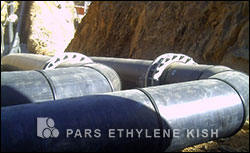Micro-Tunnelling is similar to Pipe Jacking but uses some form of mechanical excavation machine at the face. The machine can take several forms depending on ground conditions and how the spoil is removed. Two common styles are the “slurry” machine, whe re the spoil is turned into a watery slurry for removal, and the “partial open face “ machine where spoil in a relatively unchanged state is removed by skip, conveyor or auger.
re the spoil is turned into a watery slurry for removal, and the “partial open face “ machine where spoil in a relatively unchanged state is removed by skip, conveyor or auger.
This system requires a pit to be excavated to the proposed pipeline depth. The pit has to be large enough to fit the boring machine and/or pipes and the hydraulic jacks. The size required varies from machine to machine. For the smaller machines this may be as little as 1.5m. For larger machines it may be 10m or more.
The drilling machine is located in front of the first permanent pipe. Normally the pipeline is steel or concrete but other materials may be used. A steel pipe can be used as a casing with the service pipe installed inside the steel duct later. The drilling machine is steered from a control panel at the surface using remote CCTV and laser guidance.
Depending of the type of machine numerous services such as power, hydraulics, water and lubricant may need to be fed to the tunnelling machine. These services must de disconnected and then reconnected each time a new pipe is added to the string. Significant equipment and space is also needed at the surface for lifting pipes into the pit, storage of pipes and so on. For slurry machines large screens and tanks are also required at the surface to settle the muck out.
The larger machines generally drill a full size hole. Some of the smaller machines drill only a small hole (approx. 70mm) which is later reamed out to the required size. At least three of these smaller machines are presently in NZ. These smaller machines have a maximum range between pits of about 70 to 100m. After this it is difficult to see the laser guidance dot on the target. Larger machines can often tunnel for a few hundred metres between pits. The governing factor is often the pipe resistance in the hole, although this can be eased by lubrication. As the pipeline gets longer the forces become greater and the pipes may crush. In this case drive lengths can be increased with the use of intermediate jacking points.
At present it appears that this technology is economic at depths greater than about 6m and when it is necessary to lay a line very close to or under existing buildings or services that cannot tolerate the disruption caused by open cut methods. It should nevertheless be recognised that substantial surface disruption cannot be totally eliminated, and in particular the disruption that does arise will remain in the same location for a considerable period.
Advantages